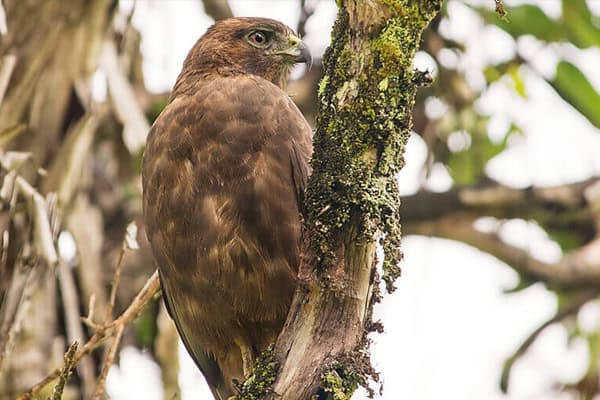27 Types of Florida Birds Of Prey (With Pictures)
Florida birds of prey are incredible hunters, thriving in the state’s diverse environments. Florida is known for its beautiful landscapes and wide variety of wildlife. One special group of animals living here is the birds of prey. These amazing birds, also called raptors, are skilled hunters who have learned to live in Florida’s many different environments. They help keep the state’s ecosystem in balance.
In this text, we will examine these powerful birds closely. We will learn about where they live, what makes them unique, and why they are important to Florida’s environment.
Florida Birds of prey are experts at hunting. With their sharp eyesight, strong claws (called talons), and powerful beaks, they are at the top of the food chain. In Florida, these birds play a key role as top predators. They keep the number of prey animals under control, which helps keep the ecosystem healthy and balanced.
Hawks Florida Birds Of Prey
Hawks, which are a varied group of birds of prey, are some of the most impressive and well-known raptors in Florida. Famous for their sharp vision, strong claws, and ability to soar through the sky, hawks are truly masters of flight. In Florida, many types of hawks have made their homes, each with its own special ways of hunting and surviving. From the mighty Red-tailed Hawk to the quick and nimble Cooper’s Hawk, these birds help keep nature in balance by controlling the populations of rodents and other small animals.
Hawks are known for their excellent eyesight, which allows them to spot prey from great heights. They are also incredibly fast and agile when chasing their prey. This group of birds shows off the beauty and skill of nature, and they highlight the amazing wildlife found in Florida. In the next sections, we will explore the unique traits and behaviours of some of the most well-known hawks that fly through Florida’s skies
1. Red-shouldered Hawk
- Scientific Name: Buteo lineatus
- Size: 15–24 inches
- Weight: 550–950 grams
- Lifespan: 10–20 years
- Diet: Small mammals, reptiles, amphibians, birds
The Red-shouldered Hawk is the most common type of hawk in Florida. It is known for its bright reddish-brown feathers and bold black-and-white markings. This hawk prefers living in forested areas and is often seen perched high on treetops, watching over its surroundings. However, it’s also common to spot them on power lines along rural roads or even in suburban neighbourhoods. One of the easiest ways to identify this hawk is by its loud, piercing call, which makes it a noticeable presence in Florida’s outdoors.

As an opportunistic hunter, the Red-shouldered Hawk eats a variety of prey, including small mammals, birds, amphibians, and reptiles in Florida. During the breeding season, these hawks perform impressive aerial displays, soaring and diving to attract mates. While they are not considered endangered, habitat loss in some parts of Florida remains a concern, making their conservation important to both scientists and nature lovers.
Red-shouldered Hawks can be found in Florida all year round.
2. Red-tailed Hawk
- Scientific Name: Buteo jamaicensis
- Size: 18–26 inches
- Weight: 690–1,600 grams
- Lifespan: 10–21 years
- Diet: Small mammals, birds, reptiles, and carrion
The Red-tailed Hawk is easily recognized by its rusty-red tail feathers, seen in adults, and a dark “belly band” of feathers across its otherwise pale chest and belly. Known for its impressive size and strong presence, this hawk is often larger than the more common Red-shouldered Hawk in Florida. With a wingspan that can reach up to four feet, the Red-tailed Hawk is an expert flyer, often seen gliding through the sky on rising warm air currents, called thermals, while searching for food.

This hawk is highly adaptable and can live in many different habitats, including forests, grasslands, and even city areas. Its diet mainly consists of small mammals, birds, and reptiles, showing how flexible it is as a hunter.
Red-tailed Hawks are found throughout Florida year-round.
3. Cooper’s Hawk
- Scientific Name: Accipiter cooperii
- Size: 14–20 inches
- Weight: 220–680 grams
- Lifespan: 10–12 years
- Diet: Small to medium-sized birds, mammals, and occasionally reptiles and insects
With the Cooper’s Hawk, we enter a different group of hawks. Unlike the Buteo hawks, which have stout bodies and shorter tails, Accipiters like the Cooper’s Hawk are more slender and have long tails that extend well past their bodies (and wing tips when perched). We’ll look at a few more Buteos later, but since they are less common, let’s focus on the Accipiters for now!
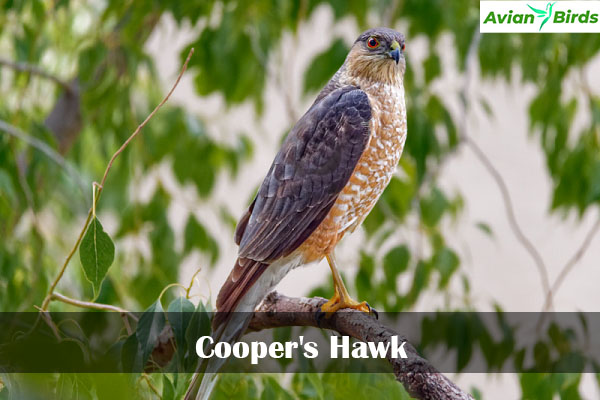
The Cooper’s Hawk stands out with its slate-grey feathers and striking red eyes in adults, although younger birds can be harder to identify. This hawk has a compact, muscular build, which helps it fly quickly and hunt with precision. Known for its agility, the Cooper’s Hawk can easily navigate through forests and suburban areas. Its primary diet consists of small birds, making it a highly skilled hunter. Using thick cover to hide, it relies on stealth and speed to ambush its prey from hidden spots.
During the breeding season, Cooper’s Hawks build nests in tall trees and are known to be very protective of their territory. They play an important role in managing populations of smaller bird species, which helps maintain balance in Florida’s bird ecosystem. Their impressive hunting skills and role in the environment make them a fascinating topic for bird watchers and scientists alike.
Cooper’s Hawks live year-round in northern and central Florida, but they only visit South Florida during the winter. They do not usually breed in the southern part of the state.
4. Sharp-shinned Hawk
- Scientific Name: Accipiter striatus
- Size: 9–13 inches
- Weight: 87–218 grams
- Lifespan: 3–5 years (up to 13 years in rare cases)
- Diet: Small birds, mammals, and occasionally insects
Sharp-shinned Hawks closely resemble Cooper’s Hawks but are much smaller. In fact, they are the smallest hawks in Florida and across the United States. Despite their size difference, telling these two species apart can be tricky because they share similar features, like slate-grey feathers and red eyes. Sharp-shinned Hawks are only found in Florida during the winter months, so if you spot an Accipiter in the summer or breeding season, it’s most likely a Cooper’s Hawk.

To distinguish a Sharp-shinned Hawk, look for a few key differences: their smaller size, a squared-off tail (instead of the Cooper’s more rounded tail), thinner legs, and the fact that they’re often found deeper in forests.
5. Short-tailed Hawk
- Scientific Name: Buteo brachyurus
- Size: 15–17 inches
- Weight: 400–700 grams
- Lifespan: 12–16 years
- Diet: Small birds, mammals, and reptiles
The Short-tailed Hawk is known for its distinctive appearance and unique colouration. One of the most interesting features of this species is its colour dimorphism, meaning there are two different colour forms within the species. The dark morph has deep brown feathers on its upper body, while the light morph displays pale grey feathers with a reddish-brown head. Both morphs, however, share a white throat and underparts.

These hawks live year-round in Florida’s southern regions, especially in the Everglades and the Florida Keys. In central Florida, including Brevard County, they can be seen during the breeding season. For example, a pair of Short-tailed Hawks is often spotted at Turkey Creek Sanctuary in Palm Bay.
Florida birds of prey, Short-tailed Hawks are agile flyers and prefer open woodlands and wetlands. Their diet mainly consists of birds, particularly small to medium-sized species, which they catch in mid-air with incredible precision.
6. Broad-winged Hawk
- Scientific Name: Buteo platypterus
- Size: 13–17 inches
- Weight: 265–560 grams
- Lifespan: 12–16 years
- Diet: Small mammals, birds, amphibians, reptiles, and insects
The Broad-winged Hawk, a remarkable migratory bird of prey, is a sight to behold as it passes through Florida during its fall migration. These hawks undertake an incredible journey, travelling from their breeding grounds in North America to their winter homes in Central and South America. Florida is an important stop along their migration path, where the hawks rest and gather strength before continuing their long trip.
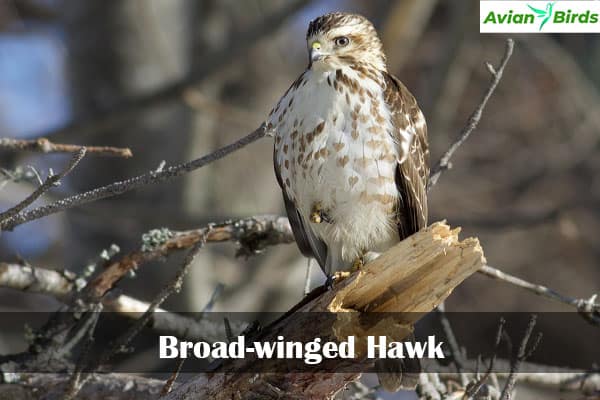
Broad-winged Hawks are easily recognized by their compact size, broad wings, and brown plumage. Their tails have bold bands, which make them stand out in flight. However, it’s their behaviour during migration that truly catches their attention. As they soar through the air, these hawks give off high-pitched calls and often gather in large flocks called “kettles.” This grouping allows them to ride on thermal air currents, helping them save energy for their long journey.
While most famous for their migration, Broad-winged Hawks can also be found in Florida’s forests outside of migration season. In these wooded areas, they hunt small mammals, birds, and occasionally reptiles, usually from hidden perches.
There is a dark version of the Broad-winged Hawk, but it is more commonly seen in the western U.S.
7. Northern Harrier
- Scientific Name: Circus hudsonius
- Size: 16–20 inches
- Weight: 290–750 grams
- Lifespan: 12–16 years
- Diet: Small mammals, birds, reptiles, and insects
The Northern Harrier, a unique low-flying raptor, can be spotted gliding over the wetlands and marshes of Florida. This hawk is easily recognized by its slender body, long wings, and a white patch on its rump that stands out against its mottled brown feathers. Be careful not to confuse it with the Snail Kite, which also has a white rump patch! Unlike most hawks, the Northern Harrier has an owl-like facial disk that enhances its hearing, helping it hunt small mammals and birds in thick vegetation.

A distinctive behaviour of the Northern Harrier is its low, graceful flight as it hovers above marshes and grasslands. Using its excellent hearing, it detects the slightest movements of prey below.
Northern Harriers visit Florida during the winter months, and I eagerly await their return each year.
Must read: Small Brown Birds In Florida
8. Osprey
- Scientific Name: Pandion haliaetus
- Size: 21–26 inches
- Weight: 1,000–2,000 grams
- Lifespan: 15–20 years
- Diet: Primarily fish
The Osprey is a distinctive bird of prey that holds a special place in Florida’s coastal ecosystems. Easily recognized by its white head, dark eye stripe, and strong hooked beak, the Osprey is a striking sight. Often called the “Fish Hawk,” this raptor’s nickname reflects its main diet—fish. Ospreys are expert fish hunters, with specialized adaptations that make them highly efficient at catching their aquatic prey.
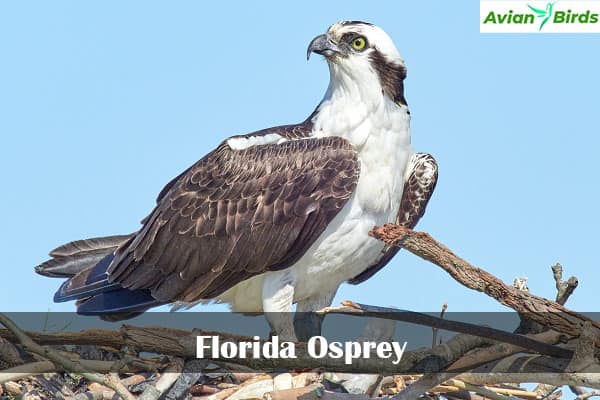
In Florida, one of Osprey’s unique behaviours is its use of utility poles for nesting. Instead of building their nests in trees, many Osprey pairs have adapted to using man-made structures like utility poles along the coast. This demonstrates their ability to adjust to environmental changes and shows how resilient they are as their habitats shift.
Ospreys play an important role in Florida’s coastal food chain by helping control fish populations. Their graceful aerial displays and incredible fishing skills make them a favourite among bird watchers and beachgoers.
Interestingly, the Osprey is not classified as a true hawk.
Eagles Florida Birds of Prey
Eagles, the majestic birds of prey soaring through Florida’s skies, are a breathtaking sight in the state’s varied ecosystems. From the well-known Bald Eagle, a symbol of national pride and environmental strength, to the rarer but equally fascinating Golden Eagle, these raptors play a special role in Florida’s birdlife. In this section, we’ll explore the traits, behaviours, and ecological importance of these remarkable eagles, highlighting their significance in maintaining the balance of Florida’s diverse wildlife.
9. Bald Eagle
- Scientific Name: Haliaeetus leucocephalus
- Size: 28–40 inches
- Weight: 3,000–6,300 grams
- Lifespan: 20–30 years
- Diet: Primarily fish, but also birds, mammals, and carrion
The Bald Eagle, a powerful symbol of national pride and ecological importance, is a majestic bird of prey that stands out in Florida’s diverse landscapes. Known for its striking appearance, with a white head and tail contrasting against a dark brown body, the Bald Eagle is an iconic sight in the state. These eagles live in Florida year-round and are commonly found near large bodies of water, such as lakes, rivers, and coastal areas.
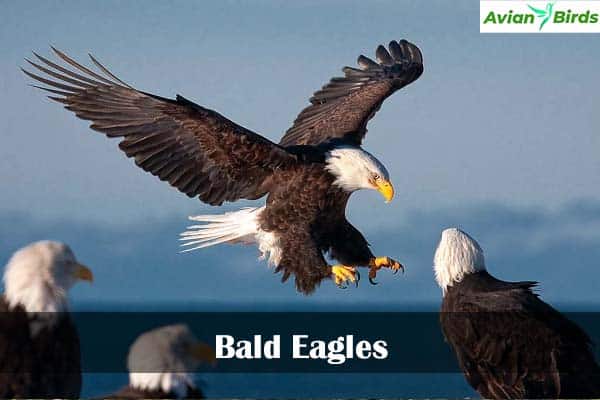
Bald Eagles are skilled hunters and scavengers, with a diet mainly consisting of fish, though they also prey on waterfowl and small mammals. With sharp eyesight and strong talons, they catch their prey with precision. In Florida, they are famous for building massive nests high up in tall trees, often near water. Conservation efforts to protect Bald Eagles have been a major success, as their populations have made a strong recovery after suffering declines due to habitat loss and harmful pesticides like DDT. Today, their ability to thrive alongside human activity makes them a symbol of both national identity and environmental recovery in Florida.
10. Golden Eagle
- Scientific Name: Aquila chrysaetos
- Size: 26–40 inches
- Weight: 3,000–6,800 grams
- Lifespan: 15–30 years
- Diet: Small to medium-sized mammals, birds, reptiles, and carrion
The golden eagle, a powerful and mysterious bird of prey, is a less common but noteworthy sight in Florida’s skies. With its dark brown feathers, feathered legs, and striking golden-brown nape, this eagle is known for its impressive size and strength. Although more commonly found in the western and mountainous regions of North America, some golden eagles migrate to Florida during the winter months.

These eagles are skilled hunters, feeding on a variety of prey, including small mammals, birds, and sometimes reptiles. They often hunt by soaring at high altitudes before diving swiftly to catch their prey. In Florida, Golden Eagles are mostly spotted in the northern and western parts of the state, particularly in open areas that provide good hunting opportunities.
Vultures Florida Birds of Prey
Soaring high above, vultures are often misunderstood scavengers, but they are crucial to maintaining Florida’s ecological balance. With their remarkable ability to detect the smell of dead animals from afar, these birds serve as nature’s cleanup crew, helping to keep the environment clean and healthy. In this section, we’ll explore the fascinating world of vultures, highlighting their unique adaptations and the important role they play in Florida’s ecosystems.
While vultures Florida birds of prey are scavengers and not typically considered raptors, we include them here because the terms “raptor” and “bird of prey” can be open to interpretation. For a detailed explanation, you can refer to Ken Kaufman’s insights on the Audubon website.
Recognizing and valuing the essential role vultures play is key to preserving the balance of Florida’s diverse ecosystems.
11. Black Vulture
- Scientific Name: Coragyps atratus
- Size: 23–27 inches
- Weight: 1,600–2,000 grams
- Lifespan: 10–25 years
- Diet: Carrion, occasionally small mammals, and eggs
Black Vultures are a familiar sight across Florida, easily recognized by their all-black feathers and short, hooked beaks. Often seen soaring on warm air currents, these vultures are vital to the ecosystem, serving as nature’s recyclers by removing dead animals and keeping the environment clean. They have sharp eyesight, allowing them to spot carrion from a distance, and they frequently follow Turkey Vultures to feeding spots.
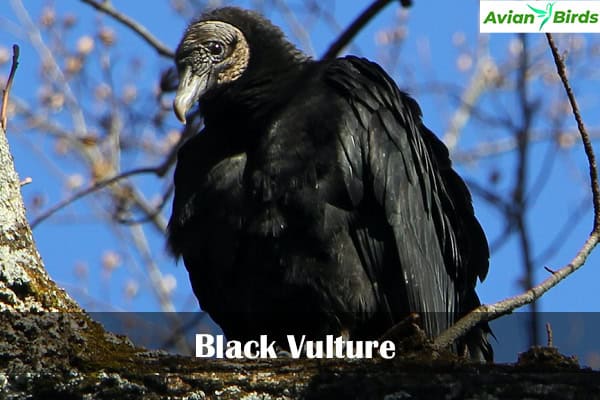
Highly social, Black Vultures often gather in large groups at communal roosts. Their ability to adapt to different environments, including urban areas, has helped them thrive even in crowded places. These vultures are excellent at cleaning up carcasses, which helps prevent the spread of disease. However, their scavenging can sometimes cause problems, such as when they peck at rubber or plastic parts of vehicles, leading to conflicts with humans.
12. Turkey Vulture
- Scientific Name: Cathartes aura
- Size: 24–32 inches
- Weight: 850–2,000 grams
- Lifespan: 16–20 years
- Diet: Primarily carrion
The Turkey Vulture, easily recognized by its red, featherless head, is another essential scavenger in Florida’s bird community. Known for their incredible sense of smell, Turkey Vultures can detect carrion from great heights, making them highly effective at cleaning up dead animals. With their large wingspans and graceful soaring flight, these vultures are a common sight in Florida’s skies, playing a critical role in removing carcasses.
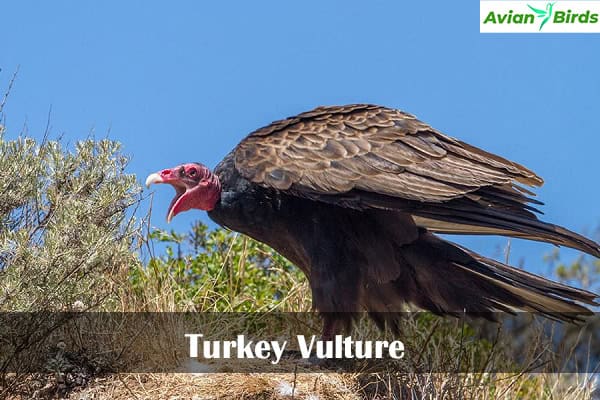
Though Turkey Vultures forage mostly on their own, they often gather in large roosts at night. Their bald heads help keep them clean while feeding, preventing bacteria from clinging to feathers. Adaptable to both wild and urban environments, Turkey Vultures fill an important ecological role by reducing the spread of diseases linked to decaying animals, ensuring the health of the ecosystem.
Owls Florida Birds of Prey
Owls, the nighttime hunters of Florida, are renowned for their silent flight and exceptional night vision. In this section, we’ll explore Florida’s owl species, their unique behaviours, and their crucial role as predators during the night. These fascinating birds help maintain balance in the ecosystem by controlling populations of small mammals and other prey.
13. Great Horned Owl
- Scientific Name: Bubo virginianus
- Size: 18–25 inches
- Weight: 910–2,500 grams
- Lifespan: 13–15 years (wild), up to 28 years (captivity)
- Diet: Small to medium-sized mammals, birds, reptiles, and insects
The Great Horned Owl rules Florida’s night skies with its iconic hoots and mysterious presence. Known for its large size and distinctive “horns,” which are actually tufts of feathers, this owl is a top nocturnal predator. It can be found across the state, from dense forests to urban areas, showcasing impressive adaptability.
As skilled hunters, Great Horned Owls have a varied diet, feeding on small to medium-sized mammals, birds, and even other owls. Their strong talons and silent flight allow them to ambush prey with precision. These owls are also famous for their deep, haunting hoots, which they use to mark territory and communicate with mates.

Among the earliest nesting birds in Florida, Great Horned Owls often take over abandoned nests from other large birds, like eagles or hawks, or build their own nests in trees. Both parents are heavily involved in caring for their young. These nocturnal predators play a crucial role in controlling rodent and small mammal populations, making them an important part of Florida’s ecosystem.
14. Barred Owl
- Scientific Name: Strix varia
- Size: 16–25 inches
- Weight: 500–1,050 grams
- Lifespan: 10–20 years
- Diet: Small mammals, birds, amphibians, reptiles, and insects
The Barred Owl, famous for its recognizable “Who cooks for you?” call, is a widely distributed and charismatic owl species in Florida. With its mottled brown and white feathers, large dark eyes, and round shape, this owl is a familiar sight in the state’s forests, swamps, and wooded wetlands.

Barred Owls are skilled hunters, feeding primarily on small mammals like mice and voles, but also birds, amphibians, and even the occasional fish. Their adaptability allows them to thrive in a range of habitats, from dense forests to suburban areas. Their loud, territorial calls serve both as communication with mates and to establish dominance in their territories.
These owls nest in tree cavities or sometimes in abandoned nests of other large birds. Both parents are dedicated caregivers, working together to raise their young. Barred Owls play a crucial role in controlling rodent populations and add to the richness of Florida’s ecosystems with their distinctive calls and nocturnal activity.
15. Barn Owl
- Scientific Name: Tyto alba
- Size: 13–15 inches
- Weight: 400–700 grams
- Lifespan: 4–10 years
- Diet: Small mammals, particularly rodents
The Barn Owl, with its heart-shaped facial disk and ghostly appearance, is a fascinating and distinctive owl species found throughout Florida. Known for its pale, almost white plumage accented with golden-brown markings, this owl is a master of silent flight and an expert nighttime hunter.
Barn Owls are highly efficient at controlling rodent populations, making them especially valuable in agricultural areas where they help manage pests like mice and rats. Their exceptional hearing allows them to detect even the slightest movements of prey in complete darkness, while their specialized feathers enable them to fly silently, sneaking up on their targets unnoticed.

In Florida, Barn Owls often make their homes in man-made structures such as barns, silos, and abandoned buildings, which is how they got their name. They also nest in tree cavities and other natural crevices. Despite their eerie look and nocturnal lifestyle, Barn Owls are a welcome presence, providing natural pest control and captivating bird lovers with their haunting calls and graceful beauty.
16. Eastern Screech-Owl
- Scientific Name: Megascops asio
- Size: 6–10 inches
- Weight: 121–244 grams
- Lifespan: 8–10 years
- Diet: Small mammals, birds, insects, and amphibians
The Eastern screech owl, a small but charming owl species, is a common and beloved resident of Florida’s woodlands and suburban areas. Easily identified by its compact size, “horn-like” feather tufts, and plumage that ranges from gray to reddish-brown, this owl is best known for its distinctive trilling calls that resonate through the night.

These nocturnal hunters have a diverse diet that includes insects, small mammals, birds, and amphibians. Eastern screech owls are masters of camouflage, blending seamlessly with tree bark, making them difficult to spot during the day. They nest in cavities, often using tree hollows, nest boxes, or even abandoned woodpecker holes for shelter.
Eastern screech owls live in Florida year-round and are highly adaptable, thriving in both natural habitats and urban environments. They can often be found nesting in parks or residential areas. Their adaptability, unique calls, and captivating appearance make them a favourite among bird watchers and an essential part of Florida’s birdlife.
17. Burrowing Owl
- Scientific Name: Athene cunicularia
- Size: 7.5–10 inches
- Weight: 140–240 grams
- Lifespan: 6–10 years
- Diet: Insects, small mammals, birds, and reptiles
The Burrowing Owl, a small and captivating species, brings a unique charm to the landscapes of southern Florida with its unusual behaviour and underground burrowing lifestyle. Recognizable by its long legs, brown plumage speckled with white, and bright yellow eyes, this owl is known for living in burrows, often repurposing tunnels made by animals like gophers or ground squirrels.

Unlike most owls, Burrowing Owls are active during the day. You can often spot them by their characteristic bobbing head movements and hear their distinctive calls, which sound like cooing whistles. Their diet varies, including insects, small mammals, and occasionally birds. The burrows they inhabit serve as both nesting sites and protection from predators and harsh weather.
These owls are commonly found in open areas like grasslands, pastures, and even urban settings. They adapt well to nesting in man-made environments such as vacant lots and ballparks. Not only are Burrowing Owls fascinating to observe, but they also play a key role in controlling insect populations. As they adapt to human development, ongoing conservation efforts are essential to protect their unique behaviours and habitats in southern Florida’s diverse ecosystems.
18. Short-eared Owl
- Scientific Name: Asio flammeus
- Size: 13–17 inches
- Weight: 206–475 grams
- Lifespan: 4–12 years
- Diet: Small mammals, especially voles, and occasionally birds
The Short-eared Owl occasionally visits Florida’s landscapes, particularly during the winter months. This owl is easily identified by its mottled brown feathers, distinct facial disk, and bright yellow eyes. Known for its unique flight patterns and low-level hunting, the Short-eared Owl is a captivating bird to observe.
These owls are highly nomadic, making them difficult to spot. They prefer open habitats such as grasslands, marshes, and coastal areas, where they use their sharp hearing and vision to hunt small mammals, especially rodents. In Florida, they sometimes find ideal foraging grounds in these environments.

Although not as frequently seen as other owls in the state, Short-eared Owls play a vital role in controlling rodent populations, helping maintain ecosystem balance. Their fascinating hunting flights, which involve hovering and gliding close to the ground, make them a special sight for birdwatchers lucky enough to encounter them in Florida’s open spaces during the winter.
19. Northern Saw-whet Owl
- Scientific Name: Aegolius acadicus
- Size: 7–8 inches
- Weight: 54–151 grams
- Lifespan: 7–10 years
- Diet: Small mammals, primarily rodents, and occasionally birds and insects
The Northern Saw-whet Owl occasionally makes an appearance in northern Florida during its migration. Small, with a rounded shape and distinct facial disk, this owl has an enigmatic and charming presence.
Typically found in coniferous and mixed forests of northern North America, the Northern Saw-whet Owl migrates during fall and spring, and a few may venture into Florida. Their diet mainly consists of small mammals, like mice and voles.

These owls are known for their secretive nature and excellent camouflage, often staying hidden in thick vegetation during the day. Their high-pitched, repetitive call—resembling the sound of a saw being sharpened—is a key identifier when they pass through Florida. Though rare in the state, their visits add an air of mystery to Florida’s birding community, thrilling those lucky enough to spot them during migration.
Falcons Florida Birds of Prey
Falcons, known for their speed and precision, are some of the most impressive birds of prey in Florida’s skies. These raptors are smaller than hawks but have distinct features like long, pointed wings and streamlined bodies, which make them expert hunters. Falcons are famous for their incredible agility and fast, powerful dives, often used to catch prey in mid-air.
20. American Kestrel
- Scientific Name: Falco sparverius
- Size: 8–12 inches
- Weight: 80–165 grams
- Lifespan: 5–9 years
- Diet: Insects, small mammals, birds, and reptiles
The American Kestrel, North America’s smallest falcon, is a vibrant and lively bird of prey commonly seen in Florida’s open landscapes. Recognizable by its compact size, colourful rufous and blue-grey plumage, and bold black markings, this agile bird is both a skilled hunter and a fast flier.
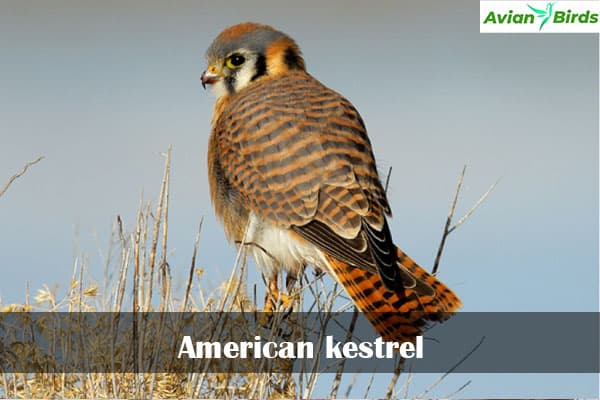
American Kestrels thrive in open habitats like grasslands, agricultural fields, and even urban areas, making Florida’s varied environments an ideal home. Their diet consists mainly of insects, small mammals, and birds, and they hunt with remarkable precision, often hovering in place before swooping down on their prey.
In Florida, you’ll often spot these kestrels perched on utility wires or fence posts, scanning for their next meal. They play an important role in controlling insect populations, contributing to the balance of Florida’s ecosystems. With their striking looks, energetic hunting style, and adaptability to city life, American Kestrels are a favourite among bird watchers and a fascinating part of Florida’s wildlife.
21. Merlin
- Scientific Name: Falco columbarius
- Size: 9–12 inches
- Weight: 160–240 grams
- Lifespan: 5–10 years
- Diet: Small birds, mammals, and insects
The Merlin Florida birds of prey, a small yet swift falcon, brings a burst of speed and agility to Florida’s skies. Known for its sleek blue-grey feathers and bold black markings, including the characteristic black “malar stripe” on its face, this falcon is an expert hunter who thrives in open landscapes.
Merlins are famous for their impressive aerial acrobatics, often seen chasing small birds in rapid, darting flights. Their diet mainly consists of small birds, but they also hunt insects and, occasionally, small mammals. In Florida, they can be found in diverse habitats, from coastal regions and estuaries to open woodlands and even urban parks.

With their striking looks and agile hunting techniques, Merlins are a favourite among birdwatchers in Florida. Their fierce expression, highlighted by the black malar stripe, adds to their distinctive appearance. These falcons play an important role in maintaining the balance of local ecosystems, helping to control bird and insect populations.
22. Peregrine Falcon
- Scientific Name: Falco peregrinus
- Size: 14–19 inches
- Weight: 500–1,500 grams
- Lifespan: 13–20 years
- Diet: Primarily birds, but also small mammals, reptiles, and insects
The Peregrine Falcon, one of the world’s most iconic and fastest birds, graces Florida’s skies with unmatched speed and hunting skill. Known for its bluish-grey feathers, bold black markings, and distinctive “hooded” look, this falcon is renowned for its astonishing aerial abilities.
Famous for its breathtaking hunting stoops, where it can dive at speeds up to 240 miles per hour, the Peregrine Falcon primarily preys on other birds, often chasing them in high-speed dives from great heights. In Florida birds of prey, these falcons are adaptable and can be found in a variety of habitats, including coastal areas, wetlands, and even urban environments.
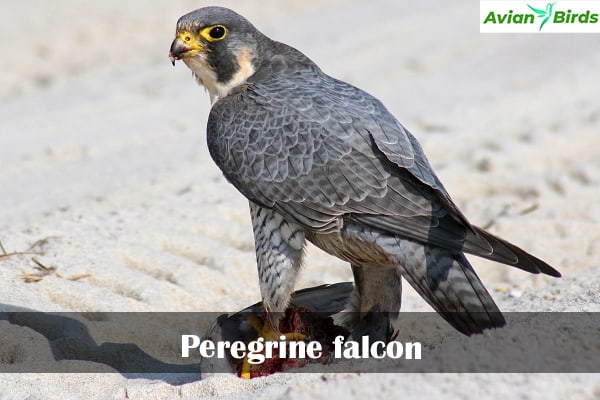
As one of the fastest birds on the planet, the Peregrine Falcon represents a true marvel of nature. Its incredible speed and striking appearance have made it a symbol of power and precision. In Florida, these falcons play an important role as top predators, helping maintain ecological balance by controlling bird populations and further showcasing the state’s rich avian diversity.
Must Visit: Red Birds in Florida
23. Crested Caracara
- Scientific Name: Caracara plancus
- Size: 19–23 inches
- Weight: 800–1,350 grams
- Lifespan: 10–20 years
- Diet: Carrion, small mammals, reptiles, insects, and birds
The Crested Caracara, a striking bird of prey, thrives in Florida’s open landscapes. Recognized for its bold black-and-white plumage, orange-yellow facial skin, and distinctive crest, this bird stands out not only for its appearance but also for its unique foraging habits and adaptability to different environments.

Crested Caracaras often inhabit grasslands, pastures, and agricultural fields, using fence posts and utility poles as vantage points to search for food. Their diet is highly varied, ranging from carrion to insects, small mammals, and reptiles. While they scavenge like vultures, they are actually more closely related to falcons, which surprises many bird watchers. Their scavenging helps keep ecosystems clean by removing carbon from the landscape.
Florida birds of prey, the Crested Caracara adds a special touch to the state’s avian diversity. With their striking appearance and interesting behaviours, like perching on fence posts to scan for prey, they captivate bird enthusiasts. These birds exemplify the adaptability of birds of prey and play a key role in maintaining the ecological balance of Florida’s diverse habitats.
Kites Florida Birds of Prey
Kites, the graceful and agile raptors, bring a touch of elegance to Florida’s skies with their effortless gliding and unique hunting techniques. These birds are known for their light and aerial movements and are a captivating sight for birdwatchers. In this section, we explore the world of Florida’s kites, highlighting their species diversity, extraordinary flight abilities, and their crucial roles in maintaining the balance of the state’s ecosystems.
24. Snail Kite
- Scientific Name: Rostrhamus sociabilis
- Size: 14–19 inches
- Weight: 300–570 grams
- Lifespan: 6–10 years
- Diet: Primarily apple snails, occasionally other freshwater snails and small aquatic animals
The Snail Kite, a distinctive raptor, is uniquely adapted to Florida’s wetland habitats, where it showcases remarkable hunting skills. Easily identified by its reddish-brown plumage, long hooked bill, sharp yellow eyes, and white tail patches, this bird has evolved to specialize in a diet primarily consisting of apple snails.
With keen eyesight, Snail Kites expertly spot apple snails in the water and use their slender, curved bills to extract the snails from their shells with incredible precision. Florida’s wetlands, especially the Everglades, offer the perfect environment for these kites to hunt and nest, as they depend heavily on these aquatic ecosystems.

The Snail Kite’s adaptations and specialized diet make it a fascinating subject for study, representing the fragile balance within Florida’s wetlands. Protecting both the Snail Kites and their habitats is essential, as they play a key role in preserving the health and biodiversity of the state’s waterways and marshes.
Also read: Woodpeckers in Florida
25. Swallow-tailed Kite
- Scientific Name: Elanoides forficatus
- Size: 19–24 inches
- Weight: 310–600 grams
- Lifespan: 6–12 years
- Diet: Insects, small reptiles, amphibians, and birds
The Swallow-tailed Kite, with its striking black and white plumage and distinctively forked tail, is a summer visitor to Florida’s skies before embarking on impressive migrations to Central and South America. Known for its graceful aerial maneuvers and elegant appearance, this kite is a symbol of freedom and beauty in flight.

During the summer, Swallow-tailed Kites nest in Florida’s forests and wetlands, feeding on insects, reptiles, and small vertebrates. As the seasons change, they embark on remarkable migrations, covering thousands of miles to winter in the lush forests of Central and South America.
Their long migration journey underscores the connection between avian species across the Americas and highlights the importance of preserving both their breeding grounds in Florida and their winter habitats. The return of Swallow-tailed Kites each year is a celebrated event for birdwatchers, showcasing the resilience and beauty of these graceful raptors.
26. Mississippi Kite
- Scientific Name: Ictinia mississippiensis
- Size: 12–15 inches
- Weight: 214–388 grams
- Lifespan: 8–12 years
- Diet: Insects (primarily), small birds, and reptiles
The Mississippi Kite, a slender and graceful raptor, adds a touch of elegance to Florida’s summer skies during its breeding season. With its soft grey feathers and distinctive dark markings around the eyes, this kite is known for its aerial acrobatics and gentle demeanour.
These kites inhabit woodlands, open fields, and even urban areas, where they primarily hunt insects like grasshoppers, crickets, and dragonflies, catching them mid-flight. During the warm months, Mississippi Kites migrate to Florida to breed, building nests in trees and tall shrubs across the state.

Their summer presence in Florida highlights the state’s importance as a seasonal refuge for migrating birds. Mississippi Kites play a valuable role in controlling insect populations, contributing to ecological balance. For bird enthusiasts, their graceful flight is a captivating sight and a reminder of the intricate connections between bird species across vast distances.
Must read: Eagles in Florida
27. White-tailed Kite
- Scientific Name: Elanus leucurus
- Size: 15–17 inches
- Weight: 250–380 grams
- Lifespan: 6–15 years
- Diet: Small mammals, primarily rodents, and occasionally birds and insects
The White-tailed Kite can often be seen gracefully soaring over Florida’s open habitats, marshes, and grasslands. Easily recognized by its bright white plumage, dark eyes, and black patches on its shoulders, this bird is admired for its elegant hunting style and ability to hover mid-air.
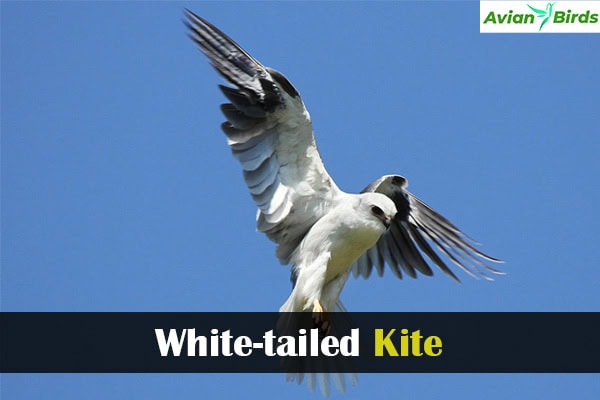
White-tailed Kites primarily prey on small mammals, especially rodents like voles and mice. They are experts at spotting prey from the air, often hovering in place before diving precisely to capture their target. This hovering behaviour, resembling a kite suspended in the wind, is one of their most distinctive traits.
In Florida, White-tailed Kites are commonly found in the southernmost regions, including the Everglades and coastal areas. Their striking appearance and unique hunting techniques make them a favourite among birdwatchers. Their adaptability to a variety of open landscapes highlights their important role in Florida’s avian community. The presence of White-tailed Kites adds an element of elegance to Florida’s skies, reflecting the state’s rich natural beauty.
Read More🐦Related Articles:
| How Long Do Chickens Live |
| European Bee-Eater (Merops apiaster) |
| Birds With Red Chests |
| African Fish Eagle: All You Need to Know |
| HAWKS IN TENNESSEE |
Conclusion
Florida’s diverse landscapes are home to a stunning variety of predatory birds, from powerful Bald Eagles to swift Mississippi Kites. Thanks to their unique adaptations and ecological contributions, each of these raptors plays a crucial role in maintaining the balance of the state’s ecosystems.
However, as human activities continue to impact the environment, it is essential to focus on conservation efforts, protect natural habitats, and embrace sustainable practices to ensure these magnificent birds continue to thrive in Florida’s skies. As we admire their beauty and fascinating behaviours, we are reminded of our shared duty to preserve the natural world. In these birds, we find inspiration and a renewed commitment to protect Florida’s birds of prey for future generations.
Frequently Asked Questions About Florida Birds Of Prey
Q1. What birds of prey live in Florida?
Florida is home to various birds of prey, including bald eagles, ospreys, hawks, falcons, owls, and vultures.
Q2. Where can I see owls in Florida?
Owls can be spotted in wildlife refuges, state parks, and forests across Florida, such as Everglades National Park and Ocala National Forest.
Q3. How to identify hawks in Florida?
Hawks in Florida can be identified by their broad wings, sharp talons, and hooked beaks. Common species include red-shouldered hawks and Cooper’s hawks.
Q4. Are bald eagles common in Florida?
Yes, bald eagles are quite common in Florida, especially near lakes, rivers, and coastal areas.
Q5. What do Florida ospreys eat?
Florida ospreys primarily eat fish, which they catch by diving into bodies of water.
Q6. When is the best time to see falcons in Florida?
Falcons are best seen in Florida during migration periods, typically in the fall and spring.
Q7. How to photograph birds of prey in Florida?
To photograph birds of prey in Florida, use a telephoto lens, shoot during early morning or late afternoon, and visit areas known for raptors, such as nature reserves.
Q8. Which raptors migrate through Florida?
Raptors such as peregrine falcons, broad-winged hawks, and kestrels migrate through Florida, especially during the fall.
Q9. What is the smallest bird of prey in Florida?
The smallest bird of prey in Florida is the American kestrel.
Q10. Do Florida vultures hunt?
No, Florida vultures are scavengers, feeding primarily on carrion rather than hunting live prey.







